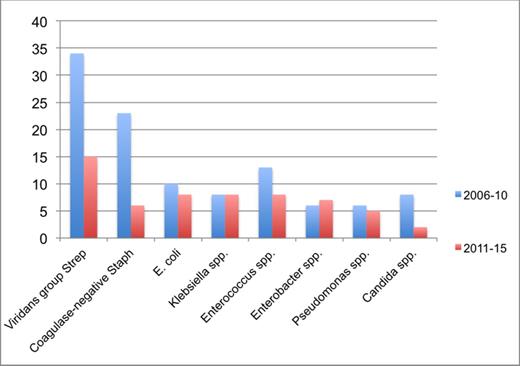Abstract
Background:
Central line associated blood stream infections (CLABSIs) are a significant source of morbidity, mortality and cost for pediatric hematology/oncology patients. In response to increasing CLABSI rates, the Hematology/Oncology division at Primary Children's Hospital (PCH) initiated a quality improvement project to reduce CLABSIs in January 2011. This effort included participation in the Children's Hospital Association (CHA) quality improvement initiative targeted at reducing CLABSIs in hematology/oncology patients from 2011 through 2015, implementation of best practice central line maintenance bundles, and ongoing monitoring of staff adherence to the maintenance care bundles.
Objective:
The objective of this study was to study the relationship and impact of implementation of a comprehensive central line care quality improvement program on CLABSI rates and bloodstream pathogens in children admitted to our hospital with benign and malignant hematological conditions.
Methods:
We retrospectively identified CLABSIs in children with a hematology/oncology diagnosis admitted to the 32 bed immunocompromised unit at Primary Children's Hospital from January 2006 through July 2015. We used the National Health Safety Network and Center for Disease Control's definition for CLABSI. The pre-intervention period was from January 2006 through December 2010. The post-intervention period was from January 2011 through July 2015. We calculated CLABSI events per 1000 line days for both the pre- and post-intervention groups. In January 2011, our hospital implemented a central line quality improvement initiative, which includedCDC-based guidelines on: daily central line assessment, hand hygiene, sterile/non-sterile gloves and mask depending on procedure, specific central line site care protocols with scrub and dressing change schedule, specific hub/cap/tubing care and parental fluid/medication administration.
Results:
More than 75% of CLABSIs in hospitalized children with a hematology/oncology diagnosis, in both the pre- and post-intervention periods occurred in patients with benign and malignant hematological conditions. From 2006-2010, there were 156 infections [4.84/1,000 line days (32,229 line days)] documented in hospitalized hematology/oncology patients of which 123 infections were in patients with any hematological condition. This decreased to 80 infections [2.86/1,000 line days (28,003 line days)] in all hospitalized hematology/oncology patients, and to 65 in patients with any hematological conditions from 2010-2015 (Fig 1). Viridans group Streptococci was the leading cause of CLABSIs in both pre- and post-intervention periods (27% and 20%, respectively), but we observed post-intervention notable decreases among Viridans group Streptococci, coagulase-negative Staphylococci, and Candida species. Gram negative and Enterococcus spp. infections appeared to remain similar in the pre- and post-intervention period (Fig 2).
Conclusion:
In both pre- and post-implementation periods, patients with benign and malignant hematological conditions comprise the majority (75%) of all hematology/oncology patients who experience CLABSI events.After implementation of a central line care quality improvement initiative in 2011, CLABSI events decreased among all hematology/oncology patients, with apparent decreases noted in infections involving Viridans group Streptococci, coagulase-negative Staphylococci and Candida spp. It appears as though CLABSIs due to organisms common to the lower gastrointestinal tract, i.e. gram negative organisms and Enterococcus spp., were similar in both study periods. This may indicate that infections involving these organisms may be less amenable to reduction with current best practice central line maintenance care bundles. Continuing to evaluate these data will not only further our understanding of CLABSIs in patients with benign and malignant hematological conditions but also bloodstream infections (BSI) in general in the hematology/oncology population. This information will guide ongoing refinements of interventions to reduce BSI in this population.
Causative pathogens in CLABSI events among patients with benign and malignant hematological conditions pre- and post-intervention
Causative pathogens in CLABSI events among patients with benign and malignant hematological conditions pre- and post-intervention
No relevant conflicts of interest to declare.
Author notes
Asterisk with author names denotes non-ASH members.



